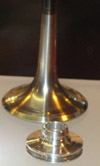Profiles critical to performance: Part 2
 Following on from my recent article on valve-head profiles, we will look a little further into the valve-head profile, and how this is applied to the modern Formula One engine. As speeds rose above 20,000 rpm in Formula One, this was an area of intense development, but the pressure has been slightly removed owing to the decrease in speeds as imposed by the yearly rev-cut regulation. Into the third year after the 20,000 rpm race engines of 2006, we now have a mandated 18,000 rpm engine speed limit.
Following on from my recent article on valve-head profiles, we will look a little further into the valve-head profile, and how this is applied to the modern Formula One engine. As speeds rose above 20,000 rpm in Formula One, this was an area of intense development, but the pressure has been slightly removed owing to the decrease in speeds as imposed by the yearly rev-cut regulation. Into the third year after the 20,000 rpm race engines of 2006, we now have a mandated 18,000 rpm engine speed limit.
As engine speeds have increased, there has been continuous development of the valves. One of the main reasons for this development is to reduce the mass of the valve in an attempt to maintain control over the valve motion with the increase in speed. In order to preserve the good breathing characteristics of the engine, the cam profile imposes ever-increasing accelerations and the consequent forces are mitigated by reductions of valve train mass. Elimination of multiple steel (or titanium) wire springs and the spring retainers by using pneumatic valve-return systems (often call air springs) was a very important step in eliminating mass. In the early days these systems often featured some quite bulky and heavy (by today’s standards) components. However, these systems now use some very lightweight parts, with at least one team using magnesium spring-tops (effectively a piston which carries a pneumatic seal) before this material was banned from use in Formula One engines. Higher system pressures mean that the size of this piston is now pretty small, with an appropriately low mass, owing to very thin walls where possible. The collets are often made from a low-density alloy, although the tappet shim (lash-cap) is still generally made from hardened steel and is often coated.
Therefore, there is only one component remaining where there is significant mass to target: the valve. There was a very significant step in reduction of valve mass with the advent of the lightweight titanium valve, although these were in common use before the appearance of the pneumatic valve-return system. Thus there has been intense pressure to reduce the mass of the valve. This problem was complicated because, as speeds increased, there was a natural tendency for the bore of the engine to increase, and with it the valve sizes – a situation which would normally lead to an increased valve mass. There are two quite obvious measures which can be taken to reduce the component weight for a given valve diameter and length; we can reduce the stem diameter, and flatten the head profile (the ‘nail-head’ profile as described last month is a good description).
In general, if we choose to reduce the stem diameter, we need to make an effort to reduce the valve-head mass; otherwise we will soon get ourselves into trouble with loss of valve control with all of the attendant problems that that can bring. The flattened ‘nail-head’ will, in many cases, bring with it an unwelcome reduction in breathing capacity. Therefore many people have, in the past, used the normal tulip-headed valve, with the valve face in the combustion chamber dished. This too has a complication in that the compression ratio is decreased owing to an increased TDC volume. This can be regained by adding a corresponding volume of material to the face of the piston pockets, or elsewhere in the combustion chamber if this is possible. Adding material to the piston means that extra effort needs to be made to reduce the mass of the piston somewhere else. There is evidence to suggest that, with a dished tulip-headed valve having an equal breathing capacity to an un-dished version, there may be a penalty in combustion efficiency which leads again to lower engine output. As we can see, there is no simple solution to valve-mass reduction.
However, we should not despair; the flattened nail-head valve can be used for its virtue of low mass and there are features which can be introduced to the valve to restore the original flow characteristics and even improve upon them. Machined features on the valve head, which need to be carefully designed which, if we aren’t to require lots of engine tests, can give us everything that we need for our lightweight valve with good breathing. Furthermore, these features can, if ill-considered and poorly designed, lead to premature valve failure.
Written by Wayne Ward.